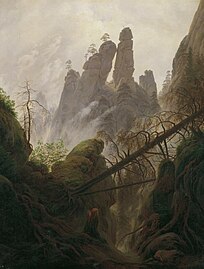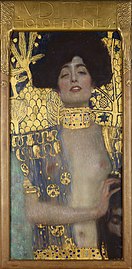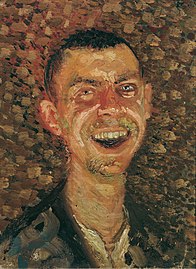Österreichische Galerie Belvedere
This article needs additional citations for verification. (August 2016) |
Das Belvedere | |
 | |
 Upper Belvedere | |
 Interactive fullscreen map | |
| Established | 1903 |
|---|---|
| Location | Prinz Eugen-Straße 27, Vienna, Austria |
| Coordinates | 48°11′29″N 16°22′51″E / 48.19139°N 16.38083°E |
| Type | Art museum |
| Visitors | 1,154,031 (2016)[1] |
| Director | Stella Rollig |
| Website | www.belvedere.at/en |
The Österreichische Galerie Belvedere is a museum housed in the Belvedere palace, in Vienna, Austria.
The Belvedere palaces were the summer residence of Prince Eugene of Savoy (1663–1736). The ensemble was built in the early eighteenth century by the famous Baroque architect, Johann Lucas von Hildebrandt, and comprises the Upper and Lower Belvedere, with the Orangery and Palace Stables, as well as extensive gardens.
Today, the Belvedere houses the greatest collection of Austrian art dating from the Middle Ages to the present day,[citation needed] complemented by the works of international artists. At the Upper Belvedere, visitors not only encounter artworks drawn from over five hundred years of art history but can also experience the magnificent staterooms. In addition to the Lower and Upper Belvedere, the museum has further sites at Prince Eugene's town palace and the 21er Haus as well as the Gustinus Ambrosi Museum.
The Belvedere's art collection presents an almost complete overview of the development of art in Austria and, thus, an insight into the country's history. The world's largest collection of Gustav Klimt's paintings lies at the heart of the presentation of Art around 1900, on show at the Upper Belvedere. Its highlights are Klimt's paintings, The Kiss (1908) and Judith and the Head of Holofernes (1901), and masterpieces by Egon Schiele and Oskar Kokoschka. Key works of French Impressionism and the greatest collection of Viennese Biedermeier art are further attractions at the museum.
History[edit]
The two Belvedere palaces housed an array of artworks even when they were the summer residence of the art patron and collector, Prince Eugene. After the Prince's death, the Habsburgs acquired some of his collections together with the palaces. Various parts of the imperial art collection were subsequently placed on display at the Belvedere from 1781 onwards. In 1903, the state's "Moderne Galerie" was opened at the Lower Belvedere. After the fall of the Austro-Hungarian monarchy, the Upper Belvedere and the Orangery were converted into museums as well. The Österreichische Galerie (Austrian Gallery), as the museum was named in 1921, came to comprise the Baroque Museum in the Lower Belvedere (opened in 1923), the Gallery of 19th Century Art at the Upper Belvedere (from 1924), and the Modern Gallery at the Orangery (from 1929). The Belvedere's collection of medieval art was first exhibited at the Orangery next to the Lower Belvedere in 1953.
In 1955, after years of rebuilding and renovation, the Upper Belvedere was reopened to the public, showing works by Gustav Klimt, Egon Schiele, Oskar Kokoschka, and other major Austrian artists.
In the years after the Second World War, there were many acquisitions and the museum was expanded and modernized. The Österreichische Galerie Belvedere is today one of the Austrian Federal Museums (Bundesmuseen) and since 2000 has been a vollrechtsfähige "wissenschaftliche Anstalt" (a legally independent public research/scientific institution).
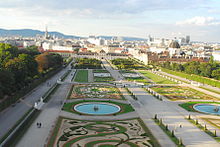
Agnes Husslein, formerly director of the Salzburg Rupertinum and the Museum der Moderne on the Mönchsberg, was director of the Belvedere between 2007 and 2016. She has positioned the Belvedere as a museum of Austrian art in an international context.
Following extensive adaptation and remodelling, the highlights of the collections of medieval and Baroque art (previously in the Lower Belvedere) have been placed on display at the Upper Belvedere since spring 2008. For the first time, the entire scope of the permanent collection, from the Middle Ages to the mid-twentieth century, can now be seen under one roof. The adapted rooms in the Lower Belvedere and Orangery now provide space for temporary exhibitions. Moreover, a study collection of the medieval holdings was set up in the former Palace Stables. The permanent collections were redisplayed in 2011.
Visitor numbers have been increasing steadily during the years of Husslein's directorship and, in 2012, they surpassed the one million mark for the first time (1,088,000 visitors).
Gallery[edit]
-
Michael Pacher, Flagellation, 1497/1498
-
Hans Makart, The Five Senses, 1872/1879
-
Gustav Klimt, The Kiss (Lovers), 1908
-
Egon Schiele, Portrait of Eduard Kosmack, 1910
-
Ernst Ludwig Kirchner, Die Klosterser Berge, 1923
-
Jacob van Schuppen, Eugene (1663–1736), Prince of Savoy, 1718
-
Johann Knapp, Huldigung an Jacquin (Homage to Jacquin), 1821–1822
-
Caspar David Friedrich, Rocky Landscape in the Elbsandsteingebirge, 1822/1823
-
Ferdinand Georg Waldmüller, Elisabeth Waldmüller, die Mutter des Künstlers, 1830
-
Claude Monet, Portrait of Père Paul, 1882
-
Richard Gerstl, Self-portrait, 1908
Nazi-looted art controversies and restitutions[edit]
- On August 26, 1959, Holocaust survivor Alice Morgenstern, the widow of Josef Morgenstern who was murdered in Auschwitz, filed a claim to the Finanzlandesdirektion für Wien, Niederösterreich und das Burgenland (Provincial Tax Office for Vienna, Lower Austria and Burgenland) in which she stated, "the picture Four Trees by Egon Schiele, which used to be owned by us, is now hanging in the Upper Belvedere. We never sold the picture but gave it to a friend, Robert Röhrl, lawyer in Vienna, Gumpendorferstrasse, for safekeeping. He unfortunately died, and I do not know how the picture landed in the nineteenth-century [recte twentieth-century] collection in the Belvedere.[2]" On March 20, 2020, the Austrian Advisory Commission recommended that the Schiele be restituted to Morgenstern's heirs.[3][4]
- In November 2006, after more than five decades of legal disputes, a panel ruled that Edvard Munch's "Summer Night at the Beach", on display at the Belvedere Gallery, was to be returned to Marina Fistoulari-Mahler, granddaughter and sole heir of Alma Mahler, wife of Austrian composer Gustav Mahler.[5][6]
- In 2006 Austria returned five paintings by Gustav Klimt from the Belvedere, to the heirs of Adele Bloch-Bauer.[7][8]
- In 2006 the Austrian arbitration panel decided that the portrait of "Amalie Zuckerkandl" by Gustav Klimt was not looted by the Nazis and did not need to be restituted.[9] The decision caused much commentary, in part because Amalie Zuckerkandl perished with her daughter in Auschwitz and in part because, as MSNBC reported "Rather than return this obviously looted painting, an Austrian arbitration panel concluded that it should stay in the Belvedere."[10]
- In 2012 a documentary Portrait of Wally told how Egon Schiele's famous portrait, which had belonged to a Viennese art dealer named Lea Bondi until the Nazi Friedrich Welz confiscated it from her private collection in 1939, was restituted by mistake to the Belvedere Museum after World War II as part of another dealer's collection.[11]
- In 2014 the Belvedere was ordered to restitute "Farmer's Kitchen / Kitchen Interior" by Wilhelm Leibl to the heirs of Martha Liebermann – Max Liebermann's widow due to Nazi persecution.[12]
References[edit]
- ^ "Visitor Figures 2016" (PDF). The Art Newspaper Review. April 2017. p. 14. Retrieved 23 March 2018.
- ^ "CASE STUDIES Egon Schiele, Four Trees/Autumn Allée" (PDF).
- ^ "Morgenstern_Josef_2020-03-06 BESCHLUSS" (PDF). provenienzforschung.gv.at. Archived (PDF) from the original on 2021-01-26.
Der Beirat sieht es demnach als erwiesen an, dass sich das Gemälde seit spätestens 1924 und – wie nunmehr durch den ausgewerteten Akt nach dem Kriegs- und Verfolgungssachschädengesetz gesichert ist – bis zumindest nach dem „Anschluss" 1938 im Eigentum von Dr. Josef Morgenstern befand, und kommt zum Ergebnis, dass der Tatbestand des § 1 Abs. 1 Z 2 Kunstrückgabegesetz erfüllt ist. Dem Bundesminister ist daher die Übereignung des Gemäldes an die Rechtsnachfolgerinnen und Rechtsnachfolger nach Dr. Josef Morgenstern zu empfehlen.
- ^ "Art Restitution Advisory Council Recommends Restitution of Egon Schiele Painting at the Belvedere". Jewish News From Austria. Retrieved 2021-04-28.
- ^ "Munch painting stolen by Nazis is returned to Mahler heir". www.lootedart.com. Retrieved 2021-04-28.
- ^ Riding, Alan (2006-11-09). "After 60 Years, Austria Will Return a Munch Work to a Mahler Heir". The New York Times. ISSN 0362-4331. Archived from the original on 2018-05-04. Retrieved 2021-04-28.
The painting, which shows the moon reflecting off a calm sea before a rocky beach and is sometimes referred to as "Seascape With Moon," has been hanging since 1940 in the Austrian Gallery, known as the Belvedere, in Vienna. The Austrian government had rejected all previous claims to the painting, most recently in 1999, on the ground that the Belvedere had legitimate title to it. Wednesday's ruling followed a recommendation earlier that day by the country's Art Restitution Commission, which followed the spirit of a new law adopted in 2001 aimed at easing the way for the return of art unjustly acquired under Nazi rule.
- ^ Waxman, Sharon (2006-04-06). "A Homecoming, in Los Angeles, for Five Klimts Looted by Nazis". The New York Times. ISSN 0362-4331. Archived from the original on 2016-08-10. Retrieved 2021-04-28.
Mr. Bloch-Bauer hung her portraits and the other Klimts in a special room in his palace as a kind of shrine to his beloved wife. But after Germany annexed Austria in March 1938, he fled without any of his belongings. The new Nazi government levied a bogus tax bill on the industrialist, and confiscated his property, placing threeof the Klimt paintings in the Austrian Gallery, and selling the rest.
- ^ "Austria to Return Art Stolen by Nazis". www.lootedart.com. New York Times. Archived from the original on 2010-11-24. Retrieved 2021-04-28.
Her husband fled to Switzerland after the Nazis took over Austria. The Nazis then took the paintings and a Belvedere gallery was made the formal owner.
- ^ "Arbitration panel decides Klimt portrait was not looted by the Nazis". www.lootedart.com. Retrieved 2021-04-28.
- ^ "The last prisoners of war: Inside the battle to recover Nazi-stolen artwork". MSNBC.com. Archived from the original on 2020-11-24. Retrieved 2021-04-28.
Portrait of Amalie Zuckerkandl by Gustav Klimt. Rather than return this obviously looted painting, an Austrian arbitration panel concluded that it should stay in the Belvedere. The arbitrators said they were not certain exactly how the painting left Ferdinand's home, and believed (despite a mountain of evidence concerning the Nazi liquidation of Ferdinand's entire estate) that Ferdinand might have decided to give the painting to Amalie's family. How this could have been accomplished while Ferdinand was in exile, the arbitrators did not explain.
- ^ Carroll, Marisa (2012-05-24). "The Painting That Launched a Thousand Lawsuits". Hyperallergic. Archived from the original on 2012-10-25. Retrieved 2021-04-28.
Rudolph Leopold, an Austrian ophthalmologist, had accumulated a staggering number of Schiele pieces in his lifetime — but not always honestly, as the documentary Portrait of Wally forcefully argues. The painting originally belonged to a Viennese art dealer named Lea Bondi, but in 1939 Friedrich Welz, a member of the Nazi Party, confiscated it from her private collection. By mistake, the painting was restituted to the Belvedere Museum in Austria after World War II as part of another dealer's collection. In 1954, Bondi asked Leopold, a known Schiele collector, to help her track down the painting. Instead, he bartered with the museum for it and made it his own.
- ^ "Belvedere muss Bild an Liebermann-Erben restituieren – Belvedere must restitute a painting to the Liebermann heirs". www.lootedart.com. Der Standard. Retrieved 2021-04-28.
External links[edit]
- Official website (in German and English)
- Virtual tour of the Österreichische Galerie Belvedere provided by Google Arts & Culture

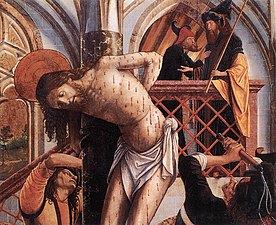





![Johann Knapp [de], Huldigung an Jacquin (Homage to Jacquin), 1821–1822](http://upload.wikimedia.org/wikipedia/commons/thumb/8/83/Johann_Knapp%2C_Huldigung_an_Jacquin.jpg/201px-Johann_Knapp%2C_Huldigung_an_Jacquin.jpg)
